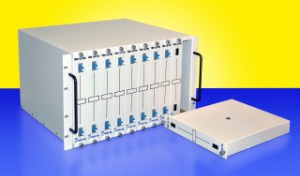For many years, communications network equipment manufacturers performed most of the lab testing efforts when designing and certifying their gear for use in the field by their customers. Now that fiber optic systems are the norm around the world for driving communications, many of the equipment users themselves are testing potential devices before deployment to determine the best solution for their own unique needs. Financial service providers, utilities, local governments, and smaller regional internet providers have recognized that having even a small and efficient lab setup where they can simulate their network and train technicians can go a long way in optimizing their operations.
The investment in a lab is a significant one, but with a proper design focused on efficiency in some key areas, it can make things a bit less daunting. For this discussion, we'll be focusing on one key area of importance - spools of optical fiber for optical link and delay simulation.
It is common knowledge that optical fiber available from manufacturers is delivered on spools, typically in just a couple of standard sizes. This straightforward approach allows the manufacturer simplicity in the shipping of the fiber, which is important given the automation involved and the sheer vast quantity of fiber being delivered. While this makes complete sense for manufacturers, it doesn't always help the engineer using it in terms of being the most efficient format to use in the lab. However, as it always arrived in the format, engineers would make do with what they receive as best they could.
Even with more efficient solutions available which we'll touch on in a moment, it's still not uncommon to see spools of bare fiber sometimes laying in an empty rack space or on a desk, unidentified spools in their original shipping clam shells, and so on. When there's just one or two spools from a manufacturer with one set of specifications, this may be okay, but that is rarely the case. Often times, this leads to a number of issues like a higher risk of broken fibers and a lot of wasted physical space.
So what is the solution? Establishing a more professional optical fiber spool setup that delivers immediate benefits, while providing a competitive advantage for equipment manufacturers and service providers or simply enhancing operations for other entities. With fiber protected and organized in a more efficient manner, it not only demonstrates an investment into better performance results, but ensures consistency while making life easier for those using it. Additionally, for training scenarios, having a more organized approach allows for a better learning environment for both trainer and student, while subsequently teaching best practices of fiber management.
 |
Reduces physical space requirements by 50% versus using standard fiber spools |
By leveraging optical fiber for link and delay simulation applications that is packaged in a professional format, entities are proven to benefit in several ways:
- Greater physical space efficiency - no more spools laying around taking up valuable space
- Consistent, accurate performance results - certify or select the best gear for the application
- Fiber protection - no more broken, crimped or damaged fibers or connectors
- Ease of use - simplified connectivity and easy fiber identification/organization
Beyond these benefits, equipment manufacturers and training centers that showcase their test lab as part of their overall value proposition have peace of mind that potential customers will be touring a well-organized, professional, and impressive testing space. Service providers deploying gear can also ensure they have specified the best equipment for their network, leading to further satisfaction or performance advantages over their competition.
 |
Fiber Lab 3200R from M2 Optics Showcases up to 320km of fiber with optional, integrated LED lighting |
Although there are certainly several other important areas of the lab to address as part of the overall setup, implementing a better approach to managing and using spools of fiber is proven to add value and advantages as discussed in this article.
With a long-term track record of success in helping the worlds most recognized entities enhance their fiber network and latency simulation capabilities, M2 Optics is the trusted partner that will deliver the expertise necessary to help engineering teams meet their goals.
LEARN MORE






